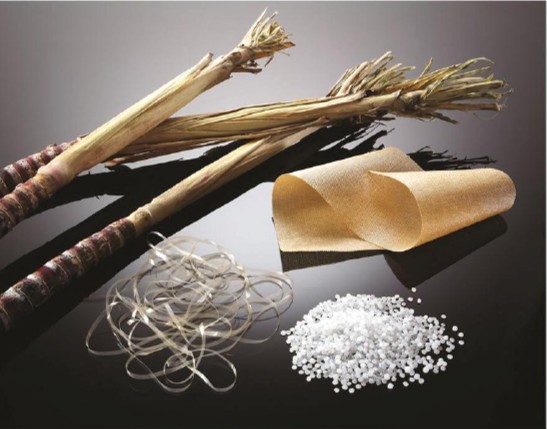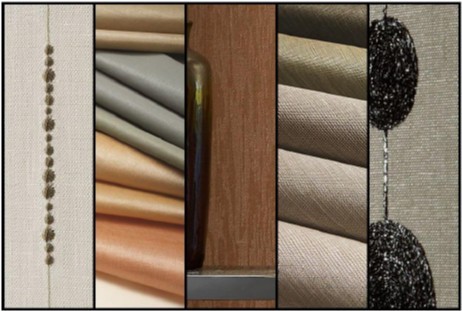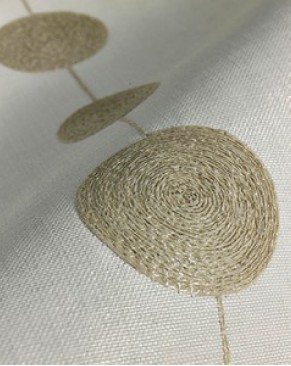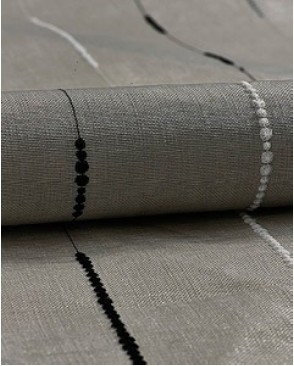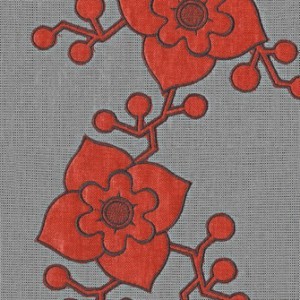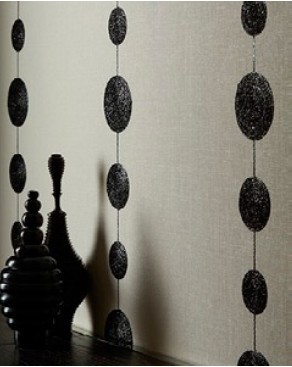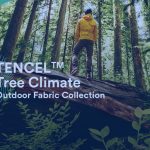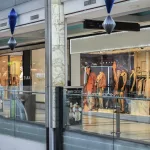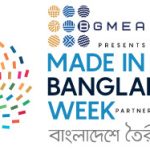Xorel is a high-performance textile typically used as wallcovering, paneling or upholstery It’s manufactured by Carnegie, an early proponent of environmentally-friendly, PVC-free fabrics. Since its launch in the ’80s, Xorel has been a popular choice for its safety, durability and for how easy it is to clean. And now it’s getting an environmental makeover that renders it even more earth-friendly.
Recently, Carnegie launched Biobased Xorel, the world’s first biobased high-end interior textile. Seven years of research culminated in a polyethylene yarn that is produced from 60 to 85 percent bio content, namely, sugar cane (rather than fossil fuels).
Sugar cane has much lower carbon emission rates compared with most other biobased materials, like corn-based materials. In fact, for each ton of sugar cane used to produce this new form of Xorel 2.5 tons of carbon is captured and sequestered. Additionally, the product can be returned to Carnegie when it is no longer needed and is recycled or put through a waste-to-energy conversion.
The Story of Carnegie Textiles
In the world of commercial interior design, it is difficult for anyone to create an original product, and even more difficult to improve on an original. Carnegie Textiles launched Xorel in 1981. It was the first textile that addressed long-term issues of maintenance and safety in commercial interiors; in many ways, it defined the category of high performance textiles and set the benchmark for customer expectations in demanding environments. Today, thirty-two years after its initial launch, Xorel continues to be Carnegie’s top selling product.
Carnegie’s founder Robert Goldman spent seven years perfecting Xorel before it was first introduced to the world of commercial interiors; his son, Carnegie president Cliff Goldman, just completed his own seven-year process of research to make Xorel the first bio-based high performance textile in the world. “The only bio-based fibers out there today for commercial use are natural products like wool, cotton and linen,” said Cliff Goldman. “I would not consider any of them to have high-performance characteristics.”
Woven from 100% solution-dyed polyethylene yarns, Xorel has always been free of chlorine, plasticizers, heavy metals, toxic dyes and ozone-depleting chemicals. “Polyethylene is basically hydrogen, carbon, color and some UV stabilizers; that means it is inherently flame-retardant, stain-resistant, antimicrobial, durable, non-absorbent and easily cleaned.”
Xorel’s only downside was an environmental one; the material to produce it originally came from natural gas, a nonrenewable resource. “Oil and natural gas are similar in that, one day our world will run dry of it,” said Mr. Goldman. “What we wanted to do was come up with a way to make the same Xorel polymer from plantbased raw materials.” Since the new bio-based Xorel continues to be made from polyethylene, it is identical to the petroleum-based Xorel on a molecular level, but the resource for creating the new Xorel is the sugarcane plant.
“The sugarcane plant has a lot of really great attributes to it,” said Mr. Goldman, “including the fact that it has a much higher yield than corn per acre. For every unit of sugarcane-based material, it makes nine and a half units of renewable energy, as opposed to corn, which results in 1.4 units of energy. In South America, countries like Brazil run on sugarcane.” Unlike many materials made from corn, sugarcane does not require genetic modification. “The other big concern with most plant-based manufacturing products is if it takes away from a food source for people. Growing sugar only takes 1% of arable land in Brazil,” he said. Plenty of room left over for the rainforest.
Showing a pile of white pellets derived from the sugarcane plant, Mr. Goldman noted, “this is what the base material looks like before color is added. We generate electricity from the sugarcane in the production plant, then add color and produce the yarn, which is all powered by biogenic energy.” As before, Xorel is produced in Europe. “Everything happens at exactly the same production facility as before,” said Mr. Goldman, “it is just that the raw material resource is different.” Looking even further ahead to the next plant-based source for Xorel, “it might algae,” added Mr. Goldman. “All of this is less about the raw material than it is about reducing the impact on the environment to create Xorel in the first place. The growth of the sugarcane plant naturally captures carbon dioxide. To produce a ton of sugarcane, you’re actually capturing two and a half tons of carbon dioxide.”
Typically when companies introduce an innovation, sustainable or other-wise, questions about available quantities of the raw material and differences in price soon get asked by designers and resource librarians. “Rest assured, the new bio-based Xorel has the same price and same performance,” said Mr. Goldman. ”We took our three most popular patterns, Strie, Nexus, and Dash, and re-colored them. This was only because they were due for re-coloring anyway,” he said. “Now, we are producing them only as biobased product.” Three new patterns, embroideries Abacus and Topiary, and an embossed design called Veneer, are also part of the bio-based Xorel launch.
Going from a measurable negative environmental impact to a positive one is not just the cost of doing business these days; priorities such as this speak to the ethical imperatives of a company. Carnegie has titled the launch of the bio-based Xorel In Our Nature, which refers not only about the core competencies of the company, but it’s inherent DNA. “Our clients usually want to know the why about any company,” said Mr. Goldman. “Why your company does what it does. There are a lot of good products out there. I think it is becoming less and less about what companies make, and more about why. We want to align ourselves with designers who think the way we think and they want to align themselves with companies that think along similar lines. This is very much about a way to run a business and think about the future.”
Carnegie’s culture as a company is focused on continuous improvement. “The nature of our company is not just about having something good and standing still,” said Mr. Goldman. Textile designer Heather Bush, Vice president of Creative at Carnegie, said, “When we look back on everything, where Xorel was and how it was the vision of Cliff’s father; in this case, Cliff had a vision for Xorel, and we pushed it forward. When we got the Cradle to Cradle Silver certification several years ago, that was our roadmap for the next step.
The previous Xorel had a Cradle to Cradle Silver listing; the new bio-based Xorel is now certified as Cradle to Cradle Gold. that means that if design firms seeking LEED certification for their projects use Cradle to Cradle Gold certified products in 2.5% of the total value of all building materials, they gain one LEED Innovation In Design Credit.
“The new Xorel does not interrupt our creative process,” said Ms. Bush. “It just makes us feel a whole lot better about it. Moving forward, we will start to transfer the product line to 100% bio-based. You could look at the two, bio-based and regular Xorel; no one can see any difference.”

Wallcovering from Carnegie, USA :
Carnegie remains the only textile/wallcovering company in this industry to have a PVC (vinyl) free policy. It’s been that way since 1990. We’ve done our research and it just makes good sense.
Showing a range of textiles neatly displayed in her studio, she gives examples of the new patterns Abacus and Topiary. “The concept of 3D printing is so fascinating to us,” she said; “we altered our embroidery process with these two patterns to bring out a third dimension. This is a new technique where we take the tape yarn of Xorel and stitch it down; it’s a totally different effect. The new patterns play with several different fiber deniers, which is the shape and thickness of the Xorel yarn. The main criteria of designing with Xorel are that the entire content of the textile has to be 100% Xorel. That is a brand promise that is about performance. If we added polyester to the face of the textile, it is not going to be as cleanable and would not be Xorel.”
For Mr. Goldman and his design team, the goal has always been to build the Xorel brand. “The Corvette came out in 1957, and it was a great design,” he said. “Chevy never changed the name of the car; they just kept on making the car better and more updated. I think it is the same for us. We are not in a race; we are looking for steady growth of our customers getting to know Xorel as a bio-based product.”
Bio-Based Xorel line of wall coverings were officially launched by Carnegie during the NeoCon – North America’s largest design exposition and conference for commercial interiors – held in Chicago from June 10-12, 2013.
Bio Xorel is the world’s first high-performance interior textile made with a majority of plant-based content (60 to 85 percent bio content), depending on pattern, though the U.S. government standard requires only 25 percent bio content for a product to carry the bio-based label.
In addition to gold level Cradle-to-Cradle certification has also achieved the SCS Indoor Advantage Gold rating and contributes toward LEED-CI (commercial interiors) categories: rapidly renewable content, indoor air quality, material transparency and material optimization. This means that those seeking LEED certification, can score points in the renewable materials and indoor air quality categories.
Bio Xorel is available in six designs in 91 colorways and can be applied for wallcovering, panel or upholstery use. Proprietary X-Protect backing enables the end-user to clean the product aggressively and with a wide range of cleaners including diluted bleach. At the end of the product’s useful life it may be returned to Carnegie for recycling or waste to energy conversion.
Carnegie (HQ)
110 North Centre Avenue Rockville Centre, NY 11570
Tel. : 800.727.6770 Fax : 516.678.6848
Email : mail@carnegiefabrics.com
